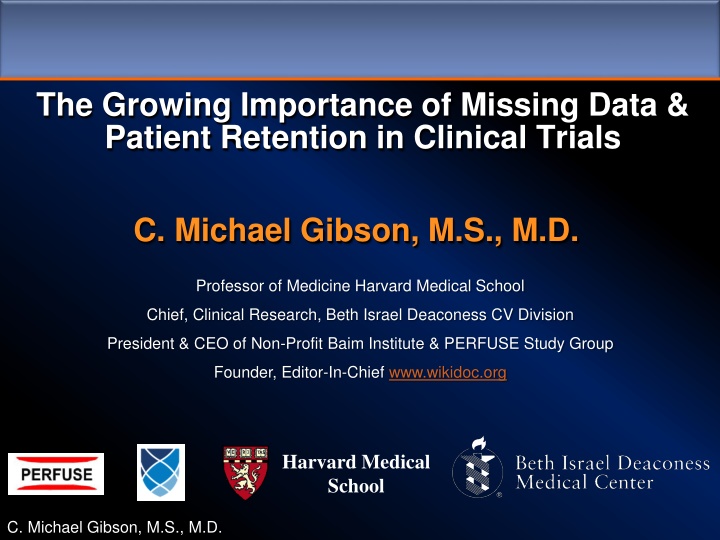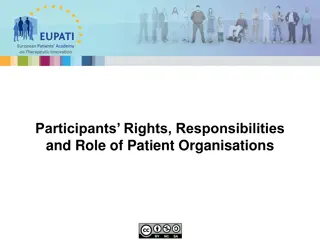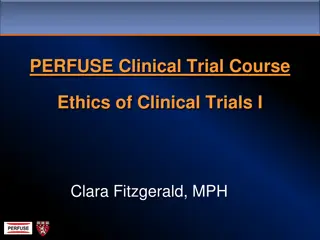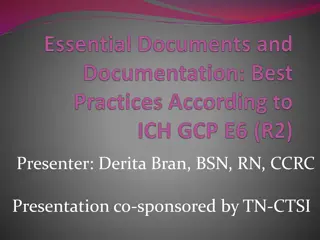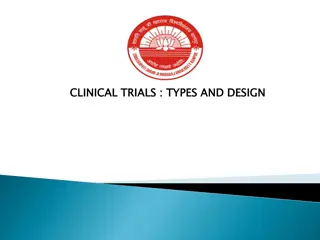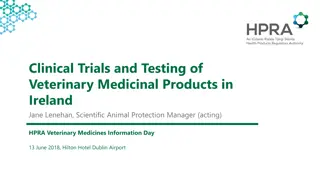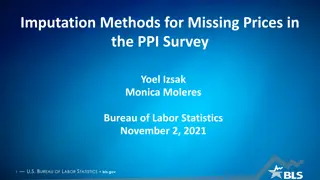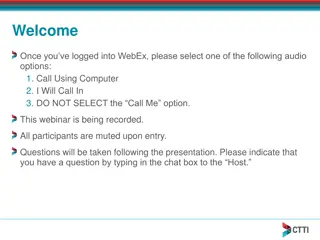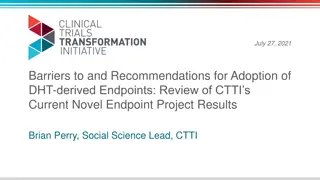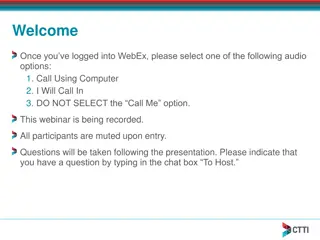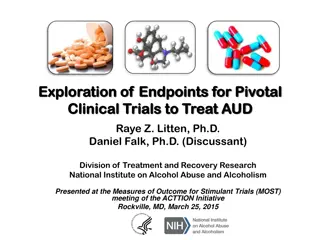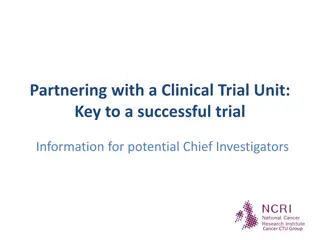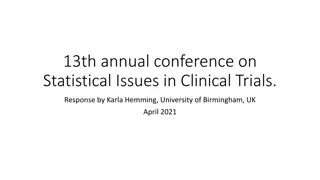The Importance of Missing Data & Patient Retention in Clinical Trials
Missing data is a growing concern in clinical trials as patients withdraw consent or fail to follow up, leading to incomplete outcomes. Dr. C. Michael Gibson highlights the impact of missing data on drug tolerance assessment and the implications for patient care. Understanding reasons for missing data and strategies for improving patient retention are crucial in ensuring the validity of clinical trial results.
Download Presentation

Please find below an Image/Link to download the presentation.
The content on the website is provided AS IS for your information and personal use only. It may not be sold, licensed, or shared on other websites without obtaining consent from the author.If you encounter any issues during the download, it is possible that the publisher has removed the file from their server.
You are allowed to download the files provided on this website for personal or commercial use, subject to the condition that they are used lawfully. All files are the property of their respective owners.
The content on the website is provided AS IS for your information and personal use only. It may not be sold, licensed, or shared on other websites without obtaining consent from the author.
E N D
Presentation Transcript
The Growing Importance of Missing Data & Patient Retention in Clinical Trials C. Michael Gibson, M.S., M.D. Professor of Medicine Harvard Medical School Chief, Clinical Research, Beth Israel Deaconess CV Division President & CEO of Non-Profit Baim Institute & PERFUSE Study Group Founder, Editor-In-Chief www.wikidoc.org Harvard Medical School C. Michael Gibson, M.S., M.D.
What is Missing Data? Missing data: Defined as absence of data for a given variable such as the outcome of a patient in a trial. Missing data is becoming increasingly frequent in clinical research as patients exercise their right to withdraw consent for participation in a trial consistent with the Declaration of Helsinki. C. Michael Gibson, M.S., M.D.
Audience Poll: If a patient discontinues study drug, does that mean they have withdrawn consent from participating in the trial? If a patient discontinues study drug (or never takes it), does that mean they should no longer be followed in the trial? C. Michael Gibson, M.S., M.D.
Reasons for Missing Data Withdrawal of consent from follow-up Discontinuation of the study drug and failure to return for follow-up (should not happen) Lost to follow-up Outcome cannot be assessed for other reasons (i.e., due to incarceration) Individual missed visits can lead to missing outcome data at selected time points C. Michael Gibson, M.S., M.D.
Withdrawal of Consent vs Drug DC vs Lost to F/U Study Drug DC Withdrew Consent Clinical Follow- Up Available No Yes Withdrew consent Discontinued Study Drug Lost to Follow-Up Yes Yes Yes No ? No No C. Michael Gibson, M.S., M.D.
Importance of Missing Data Missing data may be associated with an inability to tolerate study drug. By only analyzing patients with non-missing data, you exclude patients who were unable to tolerate study drug and the analysis cultivates out patients who successfully tolerated the study drug We obviously prescribe drugs to all patients with a disease, and we cannot identify those patients who will or will not tolerate the drug prospectively. C. Michael Gibson, M.S., M.D.
Regulatory Hypothesis A side effect like bleeding causes patients to either stop study drug or withdraw consent Patients who bleed go on to die after they exit from the study Since there is no follow-up of these patients who bled (the data is missing) the adverse consequences of bleeding or other side effect are not captured Despite favorable outcomes in the patients who did not bleed or have a side effect, these favorable outcomes may be offset by the adverse events in the patients who have missing data We will therefore assume all study drug patients with missing data died, and that all control patients with missing data lived C. Michael Gibson, M.S., M.D.
Missing Data & ITT Analyses ITT Analysis: All the patients for all of the trial. Once randomized, analyzed. Missing data erodes the ability to perform an intention to treat (ITT) analysis. An ITT analysis includes all patients randomized to therapy irrespective of protocol deviations, study drug discontinuation, or patient withdrawal. An ITT analysis maintains randomization and minimizes the potential for bias. If you do not follow all patients for the entire duration of trial due to missing data, you cannot perform an ITT analysis. You are actually performing a modified ITT analysis that censors follow-up at the time of last contact with the patient. C. Michael Gibson, M.S., M.D.
The Hierarchy of Missing Data Missing Completely at Random Least introduction of bias Missing at Random Missing Not at Random Greatest potential for introduction of bias. C. Michael Gibson, M.S., M.D.
Missing Completely at Random (MCAR) Missing Completely at Random data is independent of observed and non-observed data, and is therefore not related to the independent variables or the outcome. Examples: Loss of study files Equipment malfunction Data entered incorrectly Weather conditions that lead to a missed patient visit. C. Michael Gibson, M.S., M.D.
Missing at Random (MAR) Missing at Random data is related to independent variables (i.e., age, race, gender), but is not related to the outcome. Examples: Elderly patients drop out from an intervention due to their physical condition, but this variable is not related to the outcome. Patients drop out because of known baseline characteristics. C. Michael Gibson, M.S., M.D.
Missing Not At Random (MNAR) Missing Not at Random data is related to the outcome. This is the worst type of missing data because dropouts are related to the therapy or intervention under investigation. The pattern of missing data is related to unobserved data, making it impossible to use other values from the dataset to predict missing values. Examples: Patients discontinue study drug and withdraw from trial because they cannot tolerate a side effect of the drug like bleeding. Patients miss a visit because they had an outcome. C. Michael Gibson, M.S., M.D.
Preventing Missing Data Educate the patients about the importance of follow-up, even if study drug is discontinued early During informed consent Informed Consent Form should distinguish between withdrawal of consent and early discontinuation of study drug. The patient should prospectively be made aware that if they discontinue study drug, they must still be followed - up At every patient visit Reinforce need for complete follow-up at visits C. Michael Gibson, M.S., M.D.
Preventing Missing Data Limit individual missed visits Keep patients engaged Study newsletters, visit reminders, check-up calls Resolve barriers to visit attendance Reimburse parking and travel costs Flexible follow-up schedule Alternate methods of follow-up (i.e., Skype visits instead of in- person visits if allowed by IRB and study) C. Michael Gibson, M.S., M.D.
Preventing Missing Data If a patient discontinues study drug and the PI classifies them as having withdrawn consent, the PI must write a letter to the Executive Committee of the trial justifying lack of follow-up
Limitations in the Late Collection of Missing Data Do not wait until the end of the study or after the study is over to solve problems with missing data When contacting patients after a long period of time has elapsed since the scheduled follow-up visit, beware of recall bias: Patient may not remember side effects, bleeding episodes months after the follow-up visit was to occur, and may not remember dates of events Therefore, re-establish contact with patients as early as possible Obtain medical records to verify patient narratives C. Michael Gibson, M.S., M.D.
Process for Approaching Patients Who Have Withdrawn Consent If permitted by national and local laws, seek permission of IRB to re-consent patients who have withdrawn consent to collect data regarding the study outcome and vital status C. Michael Gibson, M.S., M.D.
Process for Locating Patients Who Are Lost to Follow-up If permitted by national and local laws, a patient locator service can be used to locate patients lost to follow-up If permitted by national and local laws, a death registry or other public records can be used to identify patients who have died C. Michael Gibson, M.S., M.D.
eCRF Should be Designed to Classify Missing Data The eCRF must capture which of the 4 following categories the patient with missing data belongs to Withdrawal of consent from follow-up Discontinuation of the study drug and failure to return for follow-up (should not happen) Loss to follow-up Other: Outcome cannot be assessed for other reasons (i.e., due to incarceration)
A Method for Classifying and Tracking Down Missing Data 100 Patients with Missing Data 7 Lost to Follow-up 23 withdrew consent 70 DC study drug 3 pts dead in death registry 4 pts alive using pt locator 23 IRBs approached 2 withdrew consent 68 followed -up 18 IRBs approve re- consent of pt 5 IRBs do not approve re- consent 18 pts provide vital status 3 pts dead in death registry
Consequences of High Rates of Missing Data in a Trial Regulators may require you to use patient locator service / death registries to track down all patients Even if you ascertain patient s vital status using death registry, you will not ascertain primary endpoint Mortality will likely be the same after withdrawal of consent, which will be interpreted as the drug did not reduce mortality You will need to re-analyze mortality data using newly ascertained vital status in missing patients to show trial was still significant C. Michael Gibson, M.S., M.D.
Strategies to Deal with Missing Data You will need to calculate not only number of missing patients, but missing time of follow-up: A patient who withdraws from the trial the day before it ends counts as a missing patient, but only 0.3% of the patient s exposure time was missing in a 1 year trial. You will need to adjust for the duration of the trial to compare the amount of missingness to other trials. A trial that goes on for two years may have twice as much missing data as a trial that goes on for one year In an event driven trial, there will be varying durations of exposure (e.g. months to years), and missingness cannot be compared to a fixed duration trial C. Michael Gibson, M.S., M.D.
Post-Hoc Strategies to Deal with Missing Data You will need to demonstrate lack of informative censoring (e.g. demonstrate no excess bleeding in treatment arm leading to withdrawal of consent 3 patients in each arm had a bleeding event preceding withdrawal of consent ) If you censor patients at the time of last contact, and assume no events after that time, you will need to demonstrate that the clinical characteristics of the subjects for whom the outcome remains unknown more closely resemble the characteristics of the subjects who completed the study without any clinical event as opposed to those patients who had an event (e.g. the TIMI Risk score of patients with missing data was the same as patients who did not have an event, but patients with events had 30% higher TIMI risk scores. Thus, patients with missing data are more like those who had no event ) You will need to do sensitivity analyses (a tipping point analysis) showing you can inflate the event rates in the patients on study drug who have missing data & preserve statistical significance (e.g. The event rates in patients randomized to study drug with missing data would need to be 10,000% higher than that observed during the course of the study to erode the observed benefit ) C. Michael Gibson, M.S., M.D.
